Visiting an Outer Island
Tuesday 18 April – Thursday 20 April 2000
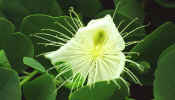 One
of our key objectives while we were in Micronesia was to visit an 'outer
island' of the Pacific. Part of the appeal was to visit somewhere very much off the
beaten track: an isolated area where people still live a very simple and
traditional way of life. The
difficulty, however, was accessibility. In
many cases, the only means by which to reach these islands was by boat, with
only one such trip made every few months. The trick was to find a place we
could reach, but few others did.
One
of our key objectives while we were in Micronesia was to visit an 'outer
island' of the Pacific. Part of the appeal was to visit somewhere very much off the
beaten track: an isolated area where people still live a very simple and
traditional way of life. The
difficulty, however, was accessibility. In
many cases, the only means by which to reach these islands was by boat, with
only one such trip made every few months. The trick was to find a place we
could reach, but few others did.
Yap has a total of 15 outer
island groups: 11 atolls and four single islands. We had read that the outer islanders of Yap were some of the
most isolated people on earth, but also knew that there were strict restrictions
on visitors making trips out to visit them.
The guidebook warned that requests had to be made in writing to the
Special Assistant for Outer Island Affairs at least a month prior to your
scheduled visit. The office, it
said, would take the request to the chief on the island you wanted to visit and
only if it were approved would you be issued a pass authorizing you to travel
there and stating the length of your stay.
Katrina at the Kosrae Village Resort had given us an exceptionally
valuable piece of advice: if anyone could help arrange the kind of visit we were
looking to do, it would be Sophiano, the key contact at the Yap Visitors Bureau
who, thanks to 20th century technology, we could contact by e-mail
prior to our arrival.
As soon as we stepped off the
plane in Yap, we were asking if anyone knew where we could find Sophiano and
within minutes we had found him, dressed in traditional Yap attire and chewing
betel nut. He assured us that he
would be able to obtain permission to visit the outer island of Fais on our
behalf, but warned us that the issue would be getting there (and back).
Given our time constraints, we did not have the luxury of waiting for the
next ship that was due to sail out there and then stay on the island for
anything up to a month or more until another one came by to take us back to Yap.
Our only option would be to fly, but there were no scheduled flights as
such and Pacific Missionary Aviation (PMA) would only make the trip with their
9-seater aircraft if there were sufficient demand.
Luckily for us, there was.
We would have a day in Yap to buy some provisions (cigarettes for the
island chief and plenty of betel nut and canned meats for the family we would be
staying with) and pack a small bag with the bare essentials for our stay.
We reckoned on being there about a week but, as the (only) PMA pilot would be
flying his family (and the plane) to Palau for a two week vacation in three day’s
time, our only option was to spend just two days on the ground.
We decided that two days were better than none and soon our thoughts were
turning to what we might expect on this journey into the unknown.
We were not to be disappointed.
Laden down with bags crammed full of canned goods, fresh
bread and other goodies, we arrived at the aircraft hanger in good time.
It was deserted apart from the pilot and other PMA staff.
Where was everybody? The
German pilot, somewhat annoyed, explained to us that people couldn’t seem to tell the
time on this island but assured us we would be leaving … once everyone had
turned up. With that, passengers
began to arrive, laden down with even more baggage than us.
Everything was weighed, including each of the passengers, and a strict
policy on excess baggage meant several of us had additional dues to pay before
we could start loading the plane.
One of our fellow travellers transpired to be a wonderful
American woman, Judy, who lived in Guam and worked as a pharmacist there.
She had come to Fais to visit Denitha Palemar, a friend she had met at a
conference a year or two back. Denitha,
who worked at the hospital in Yap, is originally from Chuuk, and is married to an
islander from Fais. They now live
in Yap with their children, and she had wanted to take Judy to visit her
husband’s family and share with her the unique charm of Fais island. To this day, we thank our lucky
stars that our paths crossed that bright, sunny morning.
Thanks to Denitha, we learnt more about outer island life than we could
ever have dared hope. We were welcomed by her husband’s family and given the
chance to share in their unique and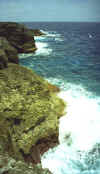 colourful culture as well as being given every opportunity to ask questions and
live their life, albeit for just a few short days.
colourful culture as well as being given every opportunity to ask questions and
live their life, albeit for just a few short days.
As we approached Fais island, we
could see the sand-coloured runway stretching almost from one end of the island
to the other. Our birds-eye vantage
point gave us a fantastic view of this square mile of land; raised limestone
with a partial fringing reef, sandy beaches and cliffs.
We could spot only two clusters of buildings from the air.
Denitha, silent either from fear or betel nut deprivation, was not to be
roused for comment but once we had landed, she confirmed that indeed there were
just two villages on the island, as well as a school and pharmacy (for which
Judy had brought supplies).
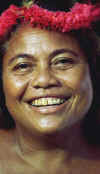 The
'airport' – a stand-to shelter – was overflowing with people.
The women, mostly seated on the ground, wore beautiful, bright lava-lavas
(traditional skirts) and the men red and blue thus (loincloths).
As the plane came to a standstill, the chief of one of the villages
(Denitha’s brother in law, Jo, no less!) came out to meet us.
Everyone was draped with flower garlands that were as fresh as they were
colorful and we, in return, offered cigarettes to relevant parties, under
Denitha’s guidance, that were accepted with a broad smile and a thank you. The baggage was unloaded and there was a general excitement
as the mail sack and several parcels that had made the trip with us appeared
from the hold. Having heard that a
plane would be leaving for Fais that morning, many locals had driven to the
airport in Yap to drop off letters, boxes of provisions and other luxuries that
they knew their family members back home would welcome. And judging by the look on everyone’s faces, the arrival of
a plane from the main island was definitely the highlight of their month, let
alone their day. The chief
apologized to us that so few people had come to meet the plane (it seemed to us
the entire island had turned out) explaining that the 'big chief' had not
wanted us to be overwhelmed and that the children had to stay in school.
We were not complaining; this was by far the biggest welcome party any of
us had ever seen!
The
'airport' – a stand-to shelter – was overflowing with people.
The women, mostly seated on the ground, wore beautiful, bright lava-lavas
(traditional skirts) and the men red and blue thus (loincloths).
As the plane came to a standstill, the chief of one of the villages
(Denitha’s brother in law, Jo, no less!) came out to meet us.
Everyone was draped with flower garlands that were as fresh as they were
colorful and we, in return, offered cigarettes to relevant parties, under
Denitha’s guidance, that were accepted with a broad smile and a thank you. The baggage was unloaded and there was a general excitement
as the mail sack and several parcels that had made the trip with us appeared
from the hold. Having heard that a
plane would be leaving for Fais that morning, many locals had driven to the
airport in Yap to drop off letters, boxes of provisions and other luxuries that
they knew their family members back home would welcome. And judging by the look on everyone’s faces, the arrival of
a plane from the main island was definitely the highlight of their month, let
alone their day. The chief
apologized to us that so few people had come to meet the plane (it seemed to us
the entire island had turned out) explaining that the 'big chief' had not
wanted us to be overwhelmed and that the children had to stay in school.
We were not complaining; this was by far the biggest welcome party any of
us had ever seen!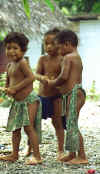
While discussions took place as
to where we should stay, we gathered under the shade of the shelter and took in
our surroundings. From where we sat
next to the airstrip, the island looked flat but definitely bigger than it had
appeared from the air. The area
around us had been cleared and beside the crushed coral runway, tall rough
grasses swayed in the breeze. Beyond
the clearing, dense plantations of coconut palms encircled us on all sides.
The pathways leading from the airstrip were nothing more than thin dirt
tracks, worn down by the light but constant foot-traffic of islanders journeying
to and from their gardens or coconut plantations.
It was decided that we would all
stay with Denitha’s family, Maggie and Jo.
We seemed to sit around for ages just chatting and began to wonder
whether we were waiting for someone (or something) before being able to head
off. But we were now on island time
and, as we soon learnt, there was no particular hurry to get anything done.
Eventually, after most of the islanders had sauntered off, Jo made a move
and began to pile some of our bags into a wheelbarrow.
With that, we headed off towards his village.
En route, we passed through the school, somewhat bigger than we had
imagined with several individual classrooms full of curious faces and eyes that
followed us observantly. At first,
we were unsure of how the children might react to us, but decided to give them a
cautious wave and instantaneously, wide smiles broke, white teeth gleaming
against tanned skin.
Many of the houses on Fais are
still built of traditional materials – wood and thatch – but we were
surprised to see several brick and corrugated iron constructions that looked
thoroughly out-of-place. We learnt
that most of them had been built after a typhoon in the 1980's, which destroyed
much of the island and convinced the islanders they needed to construct their
homes with more durable materials. Ironically,
perhaps, it soon became apparent that brick walls and corrugated iron roofs do
not make for particularly cool interiors, so during much of the year these
houses are hardly used. But as we
were soon to discover, open-air kitchens are universal and all people need for a
bed is a woven grass mat, so it hardly proved to be a major inconvenience.
With no underground wells on the
island, we were intrigued to understand where people got their water.
We noticed that almost every house had next to it a huge plastic vat, big
enough to contain thousands of gallons of water; the rain-gutters fed into these. Water was used mostly for cooking, and used sparingly;
never in our lives had we seen someone wash dishes so thoroughly with so little
water as we did Maggie. In fact,
seeing how efficiently they used such scarce resources, we refrained from
offering to help wash up, knowing we would use up at least three times as much
water and still not get everything clean.
Personal bathing usually took
place in the sea where there was a separate allotted area for men and another
for women. Worried that we might
not feel comfortable with such bathing arrangements, Maggie invited us to use
another smaller vat of water for brushing our teeth and freshening up but
Denitha cautioned us scoop it out with one bowl then pour it into another from
which we could wash so as not to contaminate the water in the main vat with
soap. We were thankful for all the
time we had spent in Borneo where we had perfected the art of taking a mandi
(bath) using a somewhat similar technique.
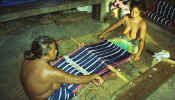 After
a lunch of rice and corned beef, we unpacked a few of the things we had brought
with us to share with everybody. We had
been advised that sMaggie’s eyes lit up at the sight of mosquito coils
and even more at the sight of peanut butter, her favorite.
Villagers seemed to appear in a continuous stream, bringing plates of
food and garlands which, Denitha explained, were a kind of welcome present.
In exchange, we would give out much sought-after delicacies such as tins
of Spam or corned beef. Judy had
also brought top-quality fishing hooks and line but, to our amusement, it was
the menthol cigarettes that seemed to produce a greater degree of interest among
the men! They used them not for
smoking, but for chewing; the taste of the tobacco is apparently excellent when
mixed with betel nut. We sat
chatting,
After
a lunch of rice and corned beef, we unpacked a few of the things we had brought
with us to share with everybody. We had
been advised that sMaggie’s eyes lit up at the sight of mosquito coils
and even more at the sight of peanut butter, her favorite.
Villagers seemed to appear in a continuous stream, bringing plates of
food and garlands which, Denitha explained, were a kind of welcome present.
In exchange, we would give out much sought-after delicacies such as tins
of Spam or corned beef. Judy had
also brought top-quality fishing hooks and line but, to our amusement, it was
the menthol cigarettes that seemed to produce a greater degree of interest among
the men! They used them not for
smoking, but for chewing; the taste of the tobacco is apparently excellent when
mixed with betel nut. We sat
chatting,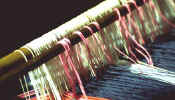 learning more about island life from Denitha, Maggie and Jo and watching Maggie
weave on her loom. Fais women are
renowned for their weaving skills and produce some of the most colourful and
intricately designed lava-lavas in Micronesia.
learning more about island life from Denitha, Maggie and Jo and watching Maggie
weave on her loom. Fais women are
renowned for their weaving skills and produce some of the most colourful and
intricately designed lava-lavas in Micronesia.
In the afternoon, we walked down
to the nearby beach: a beautiful, pristine stretch of white sand that glared so
brightly in the tropical sun it gave us a headache.
We took our fins and snorkels and spent an hour or so in the water,
watching the world beneath the waves and then sat with Denitha under the cool
shade of the coconut palms along the shore, watching the sun sink steadily lower
and wondering if there could be anywhere more idyllic on earth. In that peaceful place it was easy to forget the existence of
another life we had known, so full of hustle and bustle.
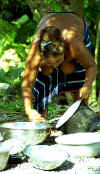 That
night we ate fresh tuna, caught by one of the men in the village just a few
hours earlier. We watched Denitha
clean it while Maggie built a fire outside in the gravel courtyard in
front of the house, using the dried husks of coconuts as fuel. She had several metal pots and pans that had obviously seen
significant use as well as a strange collection of kitchen gadgets that her son,
a student at university in the US, had sent her: cheese graters, potato peelers
and plastic bowls, among other things, for which she had found her own peculiar
uses. There may be no cheese on
Fais (and no refrigeration for that matter!) but a cheese grater is apparently
perfect for scaling fish.
That
night we ate fresh tuna, caught by one of the men in the village just a few
hours earlier. We watched Denitha
clean it while Maggie built a fire outside in the gravel courtyard in
front of the house, using the dried husks of coconuts as fuel. She had several metal pots and pans that had obviously seen
significant use as well as a strange collection of kitchen gadgets that her son,
a student at university in the US, had sent her: cheese graters, potato peelers
and plastic bowls, among other things, for which she had found her own peculiar
uses. There may be no cheese on
Fais (and no refrigeration for that matter!) but a cheese grater is apparently
perfect for scaling fish.
Jo fed the pigs leftovers from
the night before – chicken and fish bones – as well as coconut flesh from
coconuts that had been discarded after being emptied of their sweet milk.
As water was at a premium here, coconuts, which seemed to grow in
abundance everywhere, were used as the primary thirst quencher in a bid to save
their most precious commodity. In
fact, there was not a single part of the coconut that did not have a use; the
outer husk was perfect for making fires, the hair made excellent rope, the milk
an ideal drink, the flesh for cooking or feeding the pigs and the shells made
serviceable utensils.
We ate our dinner outside under
a cloudless sky; the stars shone brilliantly and the moon added some welcome
light to the low glow of the oil lamps, the only source of light after sundown.
With no electricity on the island, people relied on oil, brought in on
ships from Yap, together with other much-sought-after supplies like reels of
cotton for weaving lava-lavas. We
retired to bed early, to a wooden platform in a neighbouring house, and fell asleep to the persistent buzz of mosquitoes and the gentle
rustling of coconut palms in the humid breeze.
Pure heaven.
The next day, we awoke to major
excitement across the island; men who had been out fishing during the night
had caught a turtle. There was to
be a ceremony for its killing to which we were invited: a particular honour
for Pippa and Judy as usually women would not be permitted to attend. The ritual took place next to the island’s faluw (men’s
house), which was strictly for men only and ordinarily women would not even be
allowed near it. We were a little
apprehensive lest we commit a taboo inadvertently, but the big chief of the
island was there and waved for us to move closer to where the ceremony would
take place.
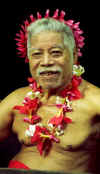 Each of the chiefs from the individual village
quarters was in attendance and each had a specific role to play.
First, the turtle, lying on its back, was clubbed to death.
It was beaten soundly to ensure it had died and then dragged down to the
beach where it was laid on a bed of dried coconut palms and set alight. This, we were told, would make the job of cutting it open
easier. By now, we were all a
little queasy. Around the world,
people are fighting to protect turtles, an ever-increasingly endangered species.
In Derawan (Borneo) we had watched as people stole freshly laid turtle
eggs to sell on the market, and now we were witnessing one of these graceful animals being reduced to
hunks of meat.
But this was real island life we were witnessing.
We were here to watch and learn, not to judge or, heaven forbid, try to
impose our ideas on these good people, clinging to their millennia-old
traditions. For them, a turtle was
part of their livelihood. They
lived almost entirely on what the sea and the island provided for them and
considered a turtle to be a highly prized gift from the heavens that was treated
with a huge degree of reverence, but also as a source of food.
Neither was this a frequent occurrence; turtles were not easy to find,
let alone catch, which was all the more reason why this ceremony was undertaken
so seriously.
Each of the chiefs from the individual village
quarters was in attendance and each had a specific role to play.
First, the turtle, lying on its back, was clubbed to death.
It was beaten soundly to ensure it had died and then dragged down to the
beach where it was laid on a bed of dried coconut palms and set alight. This, we were told, would make the job of cutting it open
easier. By now, we were all a
little queasy. Around the world,
people are fighting to protect turtles, an ever-increasingly endangered species.
In Derawan (Borneo) we had watched as people stole freshly laid turtle
eggs to sell on the market, and now we were witnessing one of these graceful animals being reduced to
hunks of meat.
But this was real island life we were witnessing.
We were here to watch and learn, not to judge or, heaven forbid, try to
impose our ideas on these good people, clinging to their millennia-old
traditions. For them, a turtle was
part of their livelihood. They
lived almost entirely on what the sea and the island provided for them and
considered a turtle to be a highly prized gift from the heavens that was treated
with a huge degree of reverence, but also as a source of food.
Neither was this a frequent occurrence; turtles were not easy to find,
let alone catch, which was all the more reason why this ceremony was undertaken
so seriously.
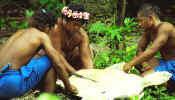 And
so we looked on, intrigued and respectful.
After the turtle had been dragged back from the beach, another chief
began to cut it open and reached inside its body to pull out its stomach and
entrails. These were placed in a
basket and hung on a tree next to the men’s house.
They would be left there for the men to cook and share out at a later
time. In the meantime, the turtle
meat (and, sadly, the eggs) were divided out among each of the village units and
the respective chief carted away his unit’s share in whatever receptacle he
had
And
so we looked on, intrigued and respectful.
After the turtle had been dragged back from the beach, another chief
began to cut it open and reached inside its body to pull out its stomach and
entrails. These were placed in a
basket and hung on a tree next to the men’s house.
They would be left there for the men to cook and share out at a later
time. In the meantime, the turtle
meat (and, sadly, the eggs) were divided out among each of the village units and
the respective chief carted away his unit’s share in whatever receptacle he
had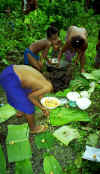 available: a wheelbarrow, a basket, a metal cooking pot.
The onlookers, men and children, began to disperse and
we followed our chief back to watch his village unit parcel out their share of
the turtle among each of the families. At
this point, the women took over and divided the meat out equally.
On the ground in front of them, several banana leaves were laid out, one
for each family and everything was divided scrupulously between them.
The whole scene was a fascinating example of structured, communal sharing, but we
had little time to dwell on it as Alfonso, the island’s doctor, offered to
take us on a tour of the island and see for ourselves the riches of this little
block of raised coral.
available: a wheelbarrow, a basket, a metal cooking pot.
The onlookers, men and children, began to disperse and
we followed our chief back to watch his village unit parcel out their share of
the turtle among each of the families. At
this point, the women took over and divided the meat out equally.
On the ground in front of them, several banana leaves were laid out, one
for each family and everything was divided scrupulously between them.
The whole scene was a fascinating example of structured, communal sharing, but we
had little time to dwell on it as Alfonso, the island’s doctor, offered to
take us on a tour of the island and see for ourselves the riches of this little
block of raised coral.
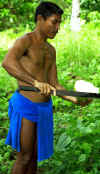 During
the past century, both the Germans and the Japanese had mined once-lush Fais for
phosphates, and the scars are evident to this day.
We saw the remains of a Japanese dock and railway track as well as parts
of a steel observation tower and the base of a shore defense gun.
The view of the island from this observation point was stunning. There is a sheer drop to the ocean from the cliff top and on
either side, stretches of beautiful white sandy beaches lined with coconut trees.
It was a very hot day and the sun beat down relentlessly.
We made frequent stops for refreshments and each time, Alfonso would
climb a nearby coconut tree and chop down fresh coconuts for us to drink.
He would assure us each time, “this is my brother’s tree” or “this
is my
uncle’s tree” lest we worry he was pinching someone else’s crop.
Each and every tree or piece of land belongs to somebody but it was
presumably not the done thing to take from anyone else’s unless, of
course, they were family.
During
the past century, both the Germans and the Japanese had mined once-lush Fais for
phosphates, and the scars are evident to this day.
We saw the remains of a Japanese dock and railway track as well as parts
of a steel observation tower and the base of a shore defense gun.
The view of the island from this observation point was stunning. There is a sheer drop to the ocean from the cliff top and on
either side, stretches of beautiful white sandy beaches lined with coconut trees.
It was a very hot day and the sun beat down relentlessly.
We made frequent stops for refreshments and each time, Alfonso would
climb a nearby coconut tree and chop down fresh coconuts for us to drink.
He would assure us each time, “this is my brother’s tree” or “this
is my
uncle’s tree” lest we worry he was pinching someone else’s crop.
Each and every tree or piece of land belongs to somebody but it was
presumably not the done thing to take from anyone else’s unless, of
course, they were family.
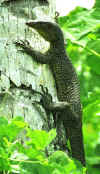 We
walked for what felt like miles. On
an island the size of Fais, that is almost impossible, but the hike was
fantastic. We spotted huge iguanas
the size of monkeys and saw an array of beautiful fauna, particularly the
flowers from which the women made garlands.
We saw the gardens that the individual families cultivated: crops of
tobacco leaves were grown to be sold whilst vegetables (mainly taro) were grown
for food. Alfonso also took us up
to the salt pools where islanders collected salt.
The spray from crashing waves below us splashed up onto the top of the
cliff, filling the indentations in the rock and, as the water evaporated in the
heat of the sun, fresh sea salt was all that remained.
To get there, we walked along a wide pathway cut out of the coral, walls
of which rose above us on either side. There
was a wonderful folk story as to how it had been made, but Alfonso, with a wry
smile, suggested that perhaps it might have been the Japanese.
We liked the other story better.
We
walked for what felt like miles. On
an island the size of Fais, that is almost impossible, but the hike was
fantastic. We spotted huge iguanas
the size of monkeys and saw an array of beautiful fauna, particularly the
flowers from which the women made garlands.
We saw the gardens that the individual families cultivated: crops of
tobacco leaves were grown to be sold whilst vegetables (mainly taro) were grown
for food. Alfonso also took us up
to the salt pools where islanders collected salt.
The spray from crashing waves below us splashed up onto the top of the
cliff, filling the indentations in the rock and, as the water evaporated in the
heat of the sun, fresh sea salt was all that remained.
To get there, we walked along a wide pathway cut out of the coral, walls
of which rose above us on either side. There
was a wonderful folk story as to how it had been made, but Alfonso, with a wry
smile, suggested that perhaps it might have been the Japanese.
We liked the other story better.
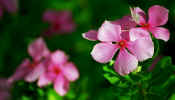 For dinner that night, we had turtle meat for the first
and probably final time in our lives (actually, it was a delicious, gamy red
meat, much better than Spam). Maggie lined up all the cooking pots full of the food (mainly
taro but prepared in several different ways) that people had continued to bring
throughout the day. As guests, we
were asked to fill our plates first. Next
in line were the men and followed by the women, but only after the men had
agreed they had had sufficient. Maggie
and Denitha laughed when we pointed out how similar our own customs had been
back home, but how, with the advent of the 21st century, things were
now very different and women expected to be treated as equals, no longer assuming
the backseat roles they had once had. We
admired their openness and, at the same time, their strong sense of tradition.
There would be many a lesson we had learnt from them during our stay that
we would take home with us and remember for a long time to come.
For dinner that night, we had turtle meat for the first
and probably final time in our lives (actually, it was a delicious, gamy red
meat, much better than Spam). Maggie lined up all the cooking pots full of the food (mainly
taro but prepared in several different ways) that people had continued to bring
throughout the day. As guests, we
were asked to fill our plates first. Next
in line were the men and followed by the women, but only after the men had
agreed they had had sufficient. Maggie
and Denitha laughed when we pointed out how similar our own customs had been
back home, but how, with the advent of the 21st century, things were
now very different and women expected to be treated as equals, no longer assuming
the backseat roles they had once had. We
admired their openness and, at the same time, their strong sense of tradition.
There would be many a lesson we had learnt from them during our stay that
we would take home with us and remember for a long time to come.
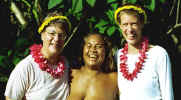 The
next morning, we began packing our bags, sad to be leaving so soon but happy we
had enjoyed such a unique opportunity to visit this special island.
We were brought several garlands by young girls and Pippa and Judy donned
lava lavas, with a western twist: t-shirts.
They were both incredulous that the local woman used nothing more than a
piece of rope to hold their skirts in place and, terrified of them coming
undone, both needed the extra help of a safety pin or two to tie them in place. In exchange for the parcels their families had sent them from
the mainland, the islanders brought bundles of tobacco leaves tied up in fresh
green banana fronds for Denitha to take back and give to their relatives.
In addition, a selection of freshly caught coconut crabs – a local
The
next morning, we began packing our bags, sad to be leaving so soon but happy we
had enjoyed such a unique opportunity to visit this special island.
We were brought several garlands by young girls and Pippa and Judy donned
lava lavas, with a western twist: t-shirts.
They were both incredulous that the local woman used nothing more than a
piece of rope to hold their skirts in place and, terrified of them coming
undone, both needed the extra help of a safety pin or two to tie them in place. In exchange for the parcels their families had sent them from
the mainland, the islanders brought bundles of tobacco leaves tied up in fresh
green banana fronds for Denitha to take back and give to their relatives.
In addition, a selection of freshly caught coconut crabs – a local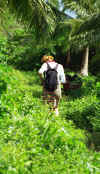 delicacy – were tied up with string and fastened up in a box for the flight
back to Yap. Little did we know
that we would see those again within the next two days.
Jo confirmed that he had had radio contact with PMA and our plane was due
at 12.30pm. We set off once again
for the airstrip and this time, as we passed through the school, the children
ran to the classroom doors, smiling and waving.
delicacy – were tied up with string and fastened up in a box for the flight
back to Yap. Little did we know
that we would see those again within the next two days.
Jo confirmed that he had had radio contact with PMA and our plane was due
at 12.30pm. We set off once again
for the airstrip and this time, as we passed through the school, the children
ran to the classroom doors, smiling and waving.
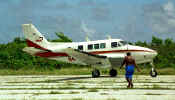 As
we took off and looked back down, we could see the islanders waving goodbye.
We circled the island before heading back to Yap and once again took in
the stunning views of the coastline and the sparkling blues and greens of the
water that surrounded them. It was
a magical last look at an island that had given us so many memories to take home,
and from which we had learnt so much about another way of life.
As
we took off and looked back down, we could see the islanders waving goodbye.
We circled the island before heading back to Yap and once again took in
the stunning views of the coastline and the sparkling blues and greens of the
water that surrounded them. It was
a magical last look at an island that had given us so many memories to take home,
and from which we had learnt so much about another way of life.